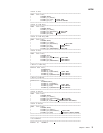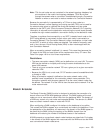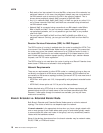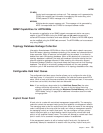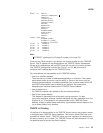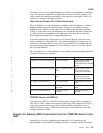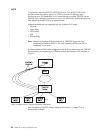focal point is designated by its entry points, which initiate communication with the
focal point, the focal point is an
implicit focal point
. The focal point for the router can
be either an explicit or implicit focal point.
Routers configured as branch extender nodes have additional flexibility. As with
conventional network nodes, the focal point can directly establish an explicit
relationship with the branch extender node. Also as with conventional network
nodes, you can configure one or more implicit focal points at the branch extender
node.
Unlike conventional network nodes, branch extender nodes can alternatively learn
of the focal point from its network node server. When the network node server
establishes a relationship with the focal point, either explicitly or implicitly, it will
notify all its served end nodes, including served branch extender nodes, of the focal
point name.
If the session between the router entry point and its primary focal point fails, the
router can initiate a session with a designated backup focal point. Before initiating a
session with a backup focal point, the router entry point makes an attempt to
reestablish communication with its primary focal point if the router has been
assigned session re-establishment responsibility. If that attempt fails, the router
switches to the backup focal point.
Note: The router will attempt to establish a session with the backup focal point, or
will attempt to re-establish the session with the primary focal point, only if the
router has an alert to send.
After switching to a backup focal point, the router will periodically attempt to
re-establish its session with the primary focal point. The interval between attempts
is doubled each time an attempt fails until a maximum interval of one day is
reached. From that point on, the attempt is performed daily.
Notes:
1. If the focal point is explicit and the explicit focal point retains the
re-establishment responsibility for itself, this retry mechanism is disabled.
2. If the focal point is explicit and assigns re-establishment responsibility to the
router, the router will attempt to reestablish communication until the next restart
of APPN in the router.
The router entry point communicates with the focal point through an LU 6.2 session.
Multiple-domain support (MDS) is the mechanism that controls the transport of
management services requests and data between these nodes. The router network
node does
not
support SSCP-PU sessions with focal points.
Management processes within the router’s control point are handled by its control
point management services (CPMS) component. The CPMS component within the
router network node collects unsolicited problem management data from resources
within the router’s domain and forwards this data to the appropriate focal point.
Supported Message Units
The router network node uses the following message units for sending and
receiving management services data, including alert messages from domain ENs:
Message unit
Description
APPN
18
MRS V3.2 Protocol Config Ref Vol 2




